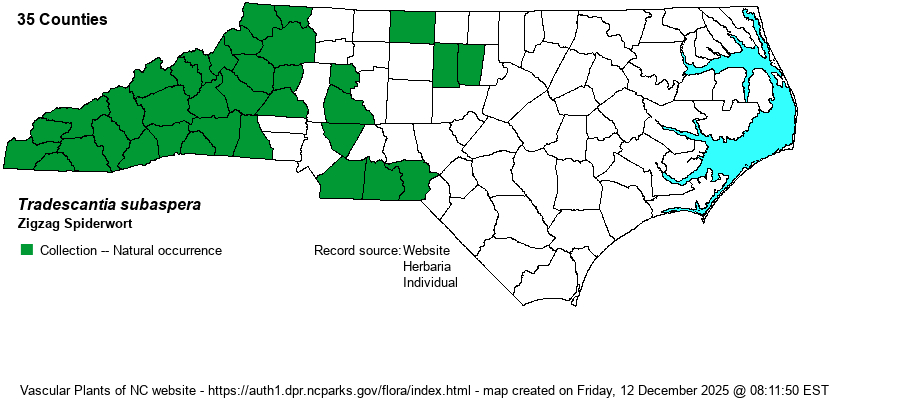| Author | Ker-Gawler | |
| Distribution | Occurs throughout the Mountains and foothills of the upper Piedmont; widely scattered over the rest of the Piedmont. Absent from the Coastal Plain. There are specimen records for all of the Mountain counties. A number of additional counties have photos on iNaturalist, but most or not confirmed owing either to confusion with T. ohiensis or simply are not identifiable. Also, several Tradescantia species are frequently planted in gardens.
This is primarily found in the Ohio and Tennessee river drainages. It ranges east to WV, central VA and NC, and eastern SC. It occurs south into northern FL and west to LA. | |
| Abundance | Frequent to common in the Mountains; fairly common in the adjacent western Piedmont, but rare and local eastward to Rockingham, Orange, and Richmond counties. | |
| Habitat | This is a species of rich to mesic forests, such as in Rich Cove Forests, Basic Mesic Forests, and Mesic Mixed Hardwood Forests. It can grow into drier forests and on top of boulders and rock outcrops. Unlike T. ohiensis, it does not grow in waste areas or open roadsides, though it certainly can occur along wooded roadbanks and forest margins. Farther eastward into the central Piedmont, it grows essentially on high pH soil in Basic Mesic Forests. | |
| Phenology | Blooms later than the other spiderworts, which often are in bloom in April and May. This species blooms in June and July, and fruits shortly after flowering. | |
| Identification | This is the most familiar woodland spiderwort in the western parts of the state, growing up to 2 feet tall, generally with a zigzag stem that bends at each leaf node. There are a number of rather broad (for a spiderwort) leaves along the stem; they average about 6 inches long and over 1 inch wide, often to 1.5 inches wide -- and they are wider than the opened sheath (if anyone is inclined to check this). The several flowers at the top of the stem average about 1 inch across; the three petals are violet-blue. The amount of hairs on various parts of the plant is a bit variable, but most parts do have some pubescence. However, most biologists identify it by 1) its mid-summer flowering period, later than other Tradescantia species; 2) the often zigzag stem; and 3) the leaves that usually are at least 1 inch wide or broader. People who hike in montane and foothill forests should be familiar with this species, and it often grows with a large array of other wildflowers, though most of those species probably would have already bloomed in the spring. | |
| Taxonomic Comments | Weakley (2018) indicates that two varieties are sometimes described, and that both occur in NC. However, he feels that these are "questionable" in validity and does not include them.
| |
| Other Common Name(s) | Wide-leaved Spiderwort | |
| State Rank | S5 | |
| Global Rank | G5 | |
| State Status | | |
| US Status | | |
| USACE-agcp | | |
| USACE-emp | | |

